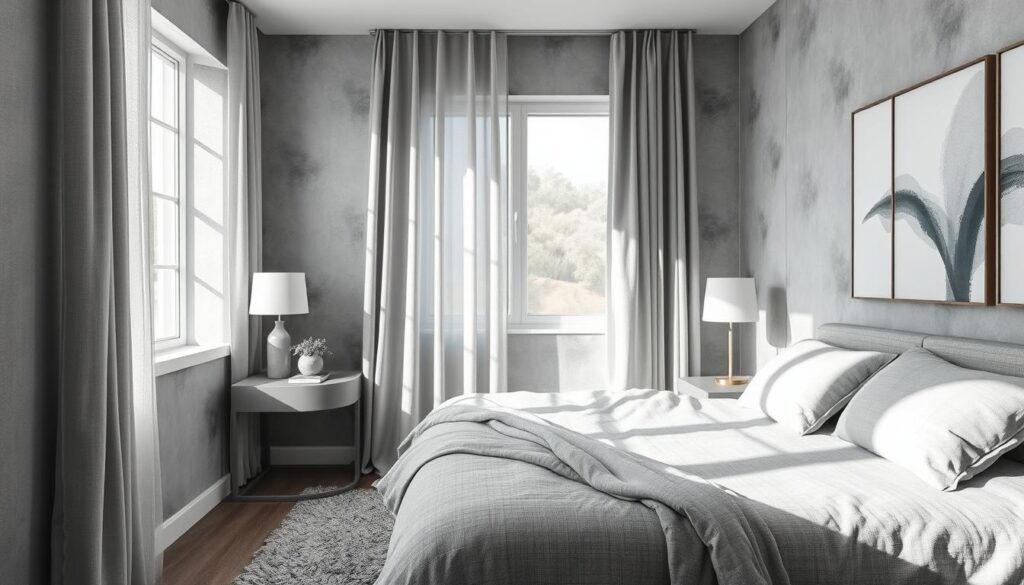Creating a guest bedroom that’s both beautiful and calm is a fun challenge. Using a monochromatic gray color scheme is a great choice. Gray colors are versatile, making your space elegant and welcoming.
In this guide, we’ll dive into the beauty of gray bedrooms. We’ll cover color theory and give you tips for styling with gray. You’ll learn how to pick the best paint colors, add textures, and use metallic accents. This will help you turn your guest room into a peaceful retreat.
Key Takeaways
- Monochromatic gray bedrooms offer a timeless and sophisticated look
- Understanding the psychology of gray and its benefits in interior design
- Techniques for creating visual interest with a single-color palette
- Selecting the right warm or cool gray tones to complement your space
- Layering different textures and materials to add depth and warmth
Understanding the Appeal of Monochromatic Gray Bedrooms
Designing a guest bedroom with a monochromatic gray color scheme may seem like a safe choice, but it’s anything but dull. The psychology of gray in interior design can actually create a calming, sophisticated atmosphere that resonates with many homeowners. Let’s explore the benefits of choosing a gray-toned palette and how to incorporate visual interest into a single-color design.
The Psychology of Gray in Interior Design
Gray is a versatile neutral that can evoke a range of emotional responses. On the cooler end of the spectrum, shades of gray can instill a sense of tranquility and serenity, making them ideal for a restful guest bedroom. Warmer grays, on the other hand, can feel more cozy and inviting. Leveraging the nuances of gray allows designers to craft a guest space that is both calming and visually compelling.
Benefits of Choosing a Monochromatic Color Scheme
- Cohesive, streamlined aesthetic
- Simplicity that allows other design elements to shine
- Flexibility to mix various textures and materials
- Timeless appeal that transcends trends
Creating Visual Interest with Single-Color Designs
While a monochromatic gray palette may seem straightforward, there are plenty of techniques to infuse visual interest and depth. Layering different shades, textures, and patterns within the same color family can prevent the space from feeling flat or one-dimensional. Thoughtful lighting choices and strategic placement of accents can also add dimension and nuance to a single-hued guest room.
“Gray is not just a compromise between black and white, but its own unique color with a dynamic and alluring presence.”
Essential Elements of Gray Color Theory
Learning about gray color theory is key for stunning monochromatic guest bedrooms. Gray can be warm and cozy or cool and calming, based on its color temperature and undertones. Knowing these elements helps you pick the right grays for your space, leading to beautiful designs.
The color temperature of gray can be warm or cool. Warm grays have beige, yellow, or red hints. Cool grays have blue or green undertones. Knowing a gray’s temperature is important, as it sets the room’s mood and feel.
- Warm grays make a room cozy and inviting, matching well with natural wood and earthy decor.
- Cool grays bring a calm, modern vibe, perfect for sleek, contemporary furniture.
Gray undertones also matter a lot. They can be subtle but greatly affect how the gray looks. Spotting undertones in a gray paint sample helps you choose wisely and avoid color clashes.
“The key to mastering gray is understanding its nuances. Paying attention to temperature and undertones will ensure you select the perfect shades for your guest bedroom.”
Exploring the basics of gray color theory prepares you to design stunning monochromatic guest bedrooms. These spaces will surely impress your guests.
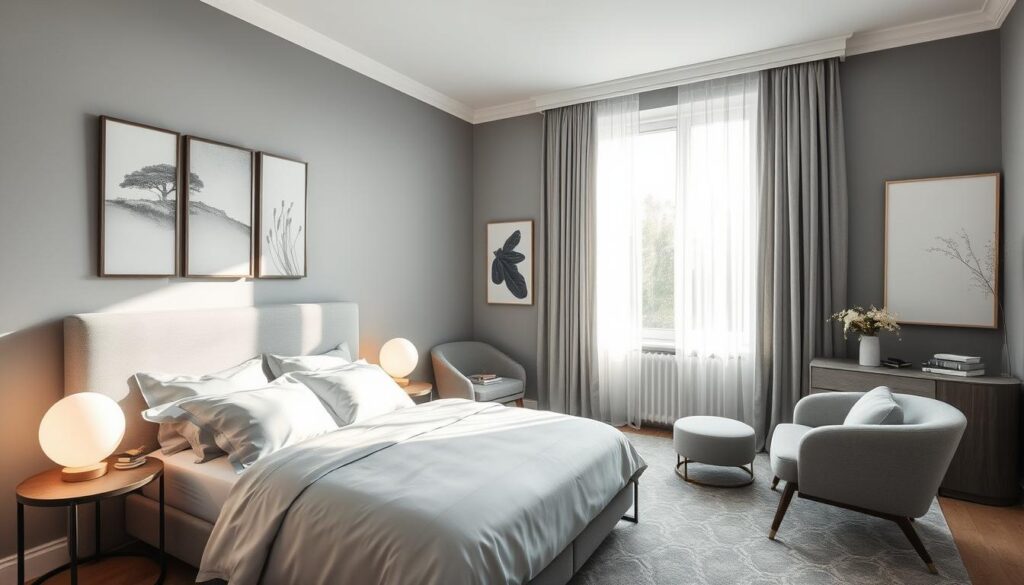
Selecting the Perfect Gray Paint Colors
Choosing the right gray paint colors is key for a soothing guest bedroom. Gray can be warm and cozy or cool and crisp, each bringing its own feel. Knowing the difference between warm and cool grays helps match your design perfectly.
Warm vs. Cool Gray Tones
Warm grays, like greige or taupe, have yellow or red undertones. They make a space feel cozy and inviting. They look great with natural wood and make rooms feel more personal.
Cool grays, with blue or green undertones, have a modern, clean look. They bring a sense of calm to any room.
Testing Paint Samples in Different Lighting
- Testing paint samples in different lights is crucial. Gray can look very different under various lighting conditions.
- Watch how the paint looks from morning to evening. This helps find the best gray for your room.
Complementary Undertones for Gray Walls
Choosing the right undertones for your gray walls is important. Warm grays go well with wood, creamy whites, and soft pastels. Cool grays complement metallics, crisp whites, and rich colors.
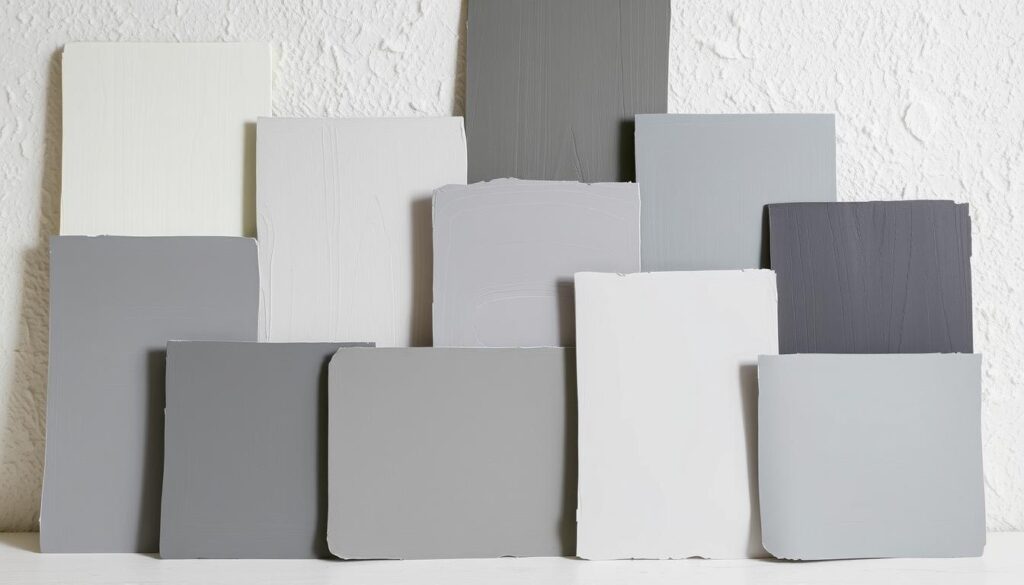
By picking the right gray and understanding its impact, you can make your guest bedroom a peaceful retreat. It will be a place your visitors will cherish.
Layering Different Gray Textures and Materials
Creating a stunning monochromatic gray guest bedroom is all about texture layering. Mixing various fabrics and materials adds depth and visual interest. This makes the space feel soothing and inviting. Discover how texture layering can transform your gray guest room.
Begin with the fabric selection for bedding, curtains, and soft furnishings. Choose a mix of smooth, velvety, and textured fabrics. For example, pair a plush velvet duvet with a crisp linen throw and chunky knit pillows.
Add varied materials like wood, metal, and glass to enhance the room’s look. A wooden dresser or nightstand, metal lamps, and a glass coffee table create contrast and depth.
- Try textured wallpapers or wall paneling for wall interest.
- Use natural stone or marble accents, like a side table or vase, for luxury.
- Layer different shades of gray in paint, furnishings, and accessories for a harmonious look.
By carefully layering textures and materials in your gray guest bedroom, you create a calming yet captivating space. It invites guests to enjoy a memorable stay.
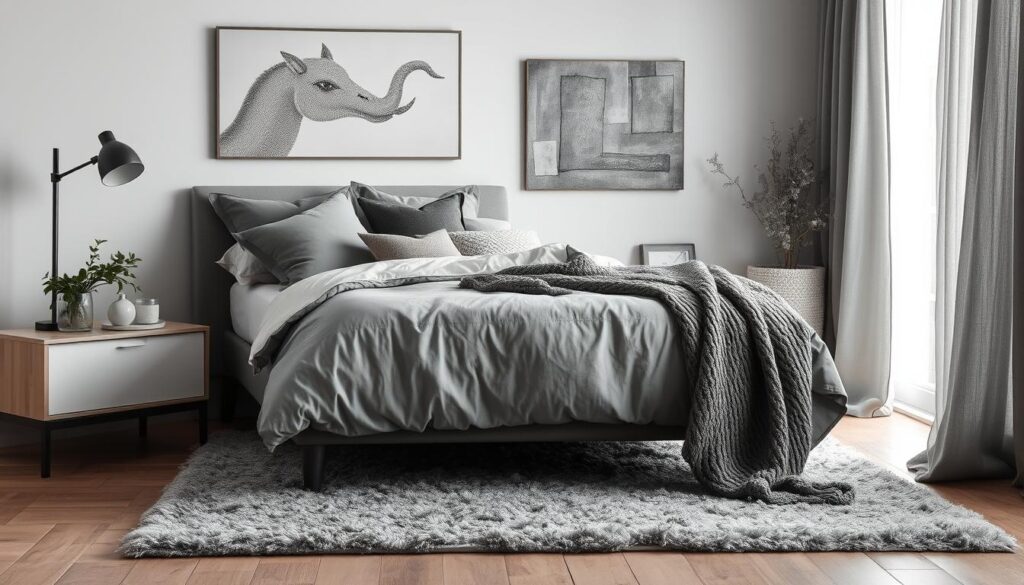
Monochromatic Guest Bedrooms: How to Style with Shades of Gray
Creating a cozy gray guest bedroom is about mixing light and dark. It’s also about adding pattern and texture. By playing with different gray tones, you can make a space that feels both sophisticated and welcoming.
Creating Depth Through Varying Tones
To add depth, use different gray shades. Start with light grays on walls and add dark accents like charcoal bedding. This mix of tones makes the room feel rich and interesting.
Balancing Light and Dark Elements
In a gray bedroom styling, balance is key. Mix light and dark grays to avoid a stark feel. Add soft lighting through windows or curtains to enhance this balance.
Incorporating Pattern and Texture
To add interest, mix pattern and texture in your gray room. Use velvets, wools, and silks for a tactile feel. Add patterned pillows, rugs, or wall hangings for depth.
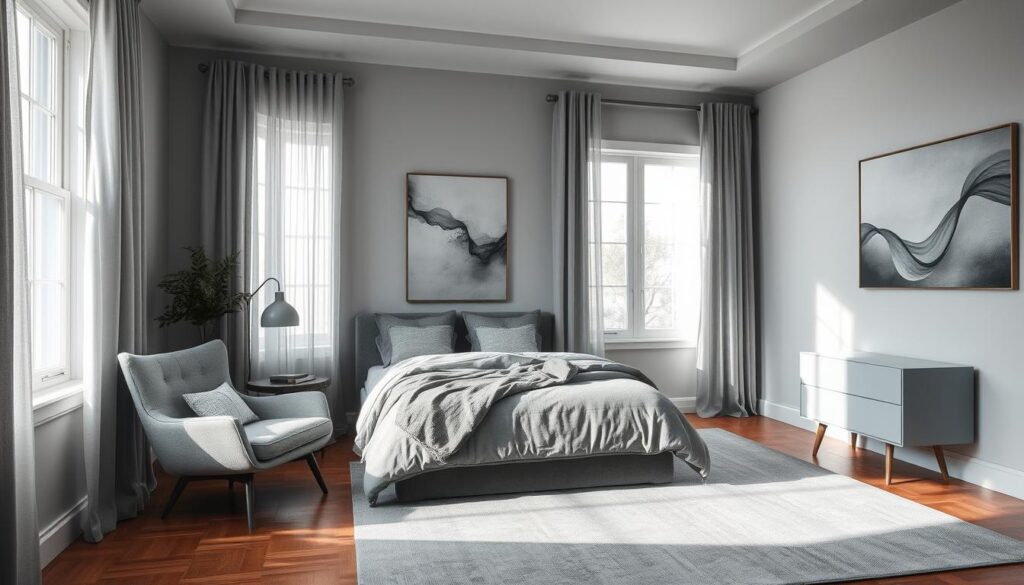
Mastering tonal variation, balancing light and dark, and adding pattern and texture turns a simple gray room into a stylish retreat. It becomes a cozy, inviting space.
Furniture Selection for Gray Guest Rooms
Choosing the right furniture is key for a gray guest bedroom. It’s all about gray bedroom furniture, upholstery choices, and bed frame styles. Each piece should complement the gray theme well.
For the bed, think about platform or panel bed frame styles. They look modern and clean. Tufted headboards or simple designs fit well with gray. Also, upholstered frames can make the room feel more luxurious.
For gray bedroom furniture, pick items with different textures and finishes. A dresser with a weathered look can stand out against shiny nightstands or a chest of drawers.
Choose upholstery choices that match gray, like velvet, linen, or leather. Use them on accent chairs, benches, or a chaise lounge. This adds a cozy touch to the room.
“The key to successful gray guest room furniture selection is to create a harmonious balance between different textures and finishes, allowing the monochromatic palette to shine.”
Lighting Solutions for Gray Spaces
Designing a gray guest bedroom is all about light. By using natural and artificial light well, you make the room welcoming. It shows off the beauty of your gray color scheme.
Natural Light Optimization
Using natural light is key to bring out gray’s depth. Add big windows, skylights, or French doors for more sunlight. Sheer curtains or blinds soften the light, making it cozy for your gray room.
Artificial Lighting Choices
Artificial light is also vital for a gray room. Mix task lights like lamps with ambient lights like sconces or chandeliers. This creates a balanced and appealing light scheme.
Creating Ambiance with Different Light Sources
Try different light sources to set the mood in your gray room. Dimmable lights adjust for reading or relaxing. Warm bulbs add coziness, while cool ones make it modern and fresh.
By mixing natural and artificial light, you make a gray room that’s both beautiful and welcoming. It’s perfect for your guests to relax in style.
Accessories and Decor Elements
To make a gray guest bedroom stand out, the right accessories and decor are key. These touches not only improve the look but also add depth and personality. They make the room feel more complete.
Begin by adding gray room accessories that match the room’s color. Artwork with gray tones, like abstract prints or landscapes, can make the walls pop. Gray throw pillows add a cozy touch to the bed. A gray area rug or runner can make the room feel warmer and more inviting.
- Try different decor accents like vases, candles, or ceramics in gray to tie everything together.
- Add styling details like fluffy throws, decorative trays, or plants to bring texture and interest.
- Adding metallic touches, like silver or gold, can bring a touch of elegance and contrast to the gray.
| Accessory | Description | Benefit |
|---|---|---|
| Gray Artwork | Abstract prints or landscape photography in gray tones | Adds visual interest and depth to the walls |
| Gray Throw Pillows | Pillows in various shades of gray, from charcoal to dove | Provides cozy layers and textural contrast to the bedding |
| Gray Area Rug | Plush, neutral-toned area rug or runner | Grounds the space and creates a sense of warmth underfoot |
Choosing the right gray room accessories, decor accents, and styling details can make your guest bedroom special. It becomes a peaceful, beautiful space that your guests will enjoy.
Incorporating Metallic Accents
Adding metallic accents can make a gray guest bedroom feel more luxurious. These shiny elements bring depth and glamour to the room. They make the gray color scheme pop.
Silver and Chrome Details
Silver and chrome decor give a modern look to the guest room. You can use them in picture frames, lamps, and side tables. These cool-toned pieces look great with gray. Just use them a little to keep the room balanced.
Gold and Brass Touches
Gold and brass add warmth and elegance to a gray room. A brass bed frame or gold-rimmed artwork can make a big statement. Pair these with lighter grays to keep the room balanced.
Mixed Metal Strategies
- Blend silver and gold accents for a layered, dynamic look.
- Incorporate chrome, brass, and copper pieces for a cohesive yet eclectic aesthetic.
- Use metallic accessories, such as candleholders, vases, and decorative trays, to add subtle sparkle.
By adding metallic accents, silver decor, and gold accessories, you can make a gray room more interesting. Try different combinations to create a space that feels fancy and inviting.
Maintaining Visual Interest in a Gray Room
Designing a gray guest bedroom needs careful thought to avoid a dull look. It’s key to add gray room interest elements. These should bring depth, texture, and contrast.
Creating a focal point is a smart move. This could be a bold headboard, a large artwork, or a striking light. It anchors the room, drawing the eye.
Using design variety is also crucial. Mix different textures, patterns, and materials. For example, smooth walls with plush bedding or wood accents.
- Try textural contrasts like velvet, linen, and leather
- Add subtle patterns for interest
- Use metallic accents for a touch of luxury
Don’t shy away from adding small pops of color. A bright throw pillow, a colorful artwork, or a plant can refresh the space. They add life and prevent the room from feeling too gray.
| Design Element | Recommendation |
|---|---|
| Textural Contrast | Mix smooth, matte surfaces with plush, tufted fabrics |
| Patterns | Introduce subtle geometric or striped patterns |
| Metallic Accents | Incorporate gold, silver, or mixed metal details |
| Color Pops | Introduce vibrant throw pillows, artwork, or greenery |
By carefully choosing gray room interest, design variety, and focal points, you can make a gray guest bedroom engaging. It will be both calming and stimulating.
Conclusion
Monochromatic gray bedrooms bring timeless elegance and versatility to any guest space. This guide has covered how to style guest bedrooms with shades of gray. It includes understanding gray’s psychological appeal and mastering texture and tone layering.
The success of a gray bedroom design comes from finding the right balance. It’s about balancing light and dark, matching undertones, and mixing patterns and textures. By choosing the right gray paint and furnishings, you can make a guest room sophisticated and welcoming.
Gray’s versatility lets you create a space that fits your style, whether modern or traditional. Add metallic accents, mix materials, and choose thoughtful lighting. With these tips, you can turn your guest room into a peaceful retreat that guests will love.
FAQ
What is the psychology of gray in interior design?
Gray is a color that brings calmness and balance to spaces. It feels tranquil and stable. It also gives a timeless feel to any room.
What are the benefits of choosing a monochromatic color scheme?
Monochromatic schemes make spaces look cohesive and harmonious. They simplify design and let you explore different textures and tones. This makes the space visually appealing.
How can I create visual interest in a single-color design?
To add interest to a gray room, use various textures and patterns. Mix different gray shades and undertones. Add accents and metallic finishes to enhance the look.
What are the key elements of gray color theory?
Understanding gray color theory is key for designing with gray. Know the difference between warm and cool grays. Recognize undertones and how they affect the space’s look.
How do I choose the perfect gray paint color?
When picking gray paint, think about the room’s lighting and the gray’s undertones. Test samples in different areas to see how the color looks.
How can I layer different gray textures and materials?
Layering gray textures and materials adds depth to a room. Mix fabrics like velvet and linen. Use different finishes, like matte and glossy, to enhance the look.
How do I create depth in a gray guest bedroom?
To add depth, use gray tones from light to dark. Balance them with light and dark elements. Patterns, textures, and layering also add interest and depth.
What furniture choices work best in a gray guest room?
Choose furniture that complements the gray color scheme. Look for gray upholstered pieces and wooden furniture with gray undertones. Metal accents also work well.
How can I optimize lighting in a gray guest room?
Good lighting is essential for a gray room’s mood. Use natural light and artificial sources like wall sconces and floor lamps. This creates a warm ambiance.
What accessories and decor elements work well in a gray guest room?
Accessories like artwork and throw pillows add to a gray room. Use rugs and decorative elements that match the color scheme. Pops of color or metallic accents can also add personality.
How can I incorporate metallic accents in a gray guest room?
Metallic accents like silver and gold add elegance to a gray room. Mix different metallic finishes for a cohesive and interesting design.
How can I maintain visual interest in a gray guest room?
To keep the room interesting, create focal points and introduce contrasting elements. Use subtle pops of color. This prevents the space from feeling flat.
Share this post: on Twitter on Facebook

